"We live in a rainbow of chaos." - Paul Cezanne
My office at home started out sleek and minimal, but now that I have used it for a few years, it has become quite jammed with stuff. Every now and then I make a half-hearted attempt to clean it, but the clutter is winning. The shelves are stacked with art books and magazines, the in-box on my desk is bulging with unanswered mail, and the walls are plastered with old posters, framed drawings, and colorful sketches made by my daughters. Yes, it looks like the office of a busy middle-aged art writer/professor/dad, which I am.
Looming above the giant bean bag chair which my wife and three daughters lounge on when they come in to chat is a gnarly, riveting red, black and grey abstract oil painting. At one point or another each of my daughters has glanced up at it and asked me the same question: "Dad, what is that?"
"Well," I tell them, "that is 'Insanity' and it was painted by my friend Steve Sas Schwartz when he and I were grad students in painting at UC Berkeley in the early 1980s." At that point, the conversation generally shifts and we talk about other things, like when will their allowances be going up, or when can we get a new goldfish.

Steve Sas Schwartz, "Insanity," 1983, 40 x 36 inches, oil on canvas
Of course, when I look at "Insanity" I see a window into a whole different phase of my life. Recently, I got back in touch with Steve, who is now raising three daughters of his own and running a clothing business -- GGOClothing -- in addition to painting. We have been talking about the old days, about art, and about what painting meant to us 30 years ago and now. It has been interesting: we chat on our cellphones, via bluetooth, while Steve is stuck in LA traffic and I am stuck in Inland Empire traffic.
At the age of 24 I was a graduate student at UC Berkeley, a school where some noted veterans of the Bay Area art scene -- including Elmer Bischoff and Joan Brown -- were on the faculty. Before coming to Berkeley I had earned my BA in Art at Stanford University, a sprawling peaceful campus with broad green lawns where I felt sheltered from the world's gritty realities.
The first day I came to Berkeley to turn in some enrollment papers a man wearing a gas mask handed me a political pamphlet as I got out of my car. The spirit of 60s revolt was still alive at Berkeley, even during the Reagan presidency. Some of the good that had come out of the 60s -- the sense of idealism and the yearning for change -- was there, but so was a lingering sense of anger and disappointment. It was a stimulating and somewhat confusing place and time.
One of the first people I met at UCB was Steve Sas Schwartz, who was a few years younger than I was. He was a charismatic guy, a smooth talker, and an easy person to become acquainted with. Even before I got to know Steve well as a person I remember being interested in his paintings. He had a show in the Worth Ryder Gallery, downstairs in Kroeber Hall, that featured a group of small, dark geometric paintings along with some richly painted abstractions that featured lush, gestural applications of paint. Steve still has a photo of that show in his personal album.
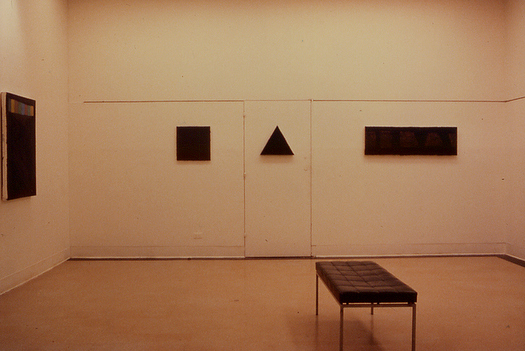
Steve's 1981 exhibit in the Worth Ryder Gallery in Kroeber Hall
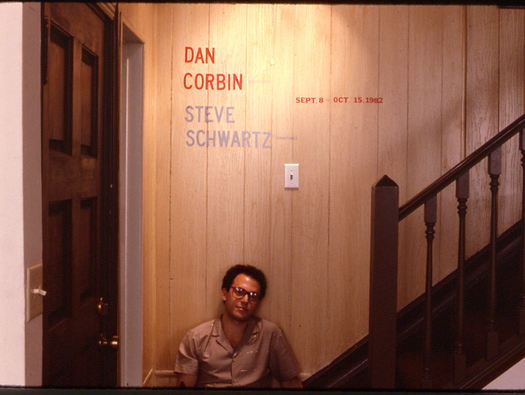
Steve Schwartz in 1982
Unlike so many of the art students at Berkeley, who had very political or theoretical points to make, Steve simply had a physical love of art making and a gutsy energetic approach to making things. I remember once asking him what he did if he felt stuck while painting, and he replied with something along the lines of "Well, I just paint through it." I have often felt that someone at Nike's advertising agency somehow stole "Just Do It" from Steve. As Steve recalls, as a young man he was completely in love with where he was in life, and completely immersed in the creative atmosphere of UCB. Talking about this nearly 30 years later, here is how Steve remembers things:

Steve Sas Schwartz "Reverberations," 1982, oil on canvas, 66" x 73
Collection of Virginia Conessa/Tim O'Hara
As Steve's paintings developed over time I was always keeping an eye on what he was doing. They always had amazing surfaces painted wet on wet, and even in their finished state Steve's paintings suggested that some kind of creative energy was still alive and present. Steve recalls that when I saw his newly finished painting "Reverberations" one day I exclaimed "My God, you have taken it to a whole other level!" I don't remember, but I bet I did say that.
I remember finding Steve's paintings very emotional, and their wacky and poetic titles added to the off-kilter, disconcerting energy. Steve says that "...many of my paintings at that time -- particularly the concentric circle galactic referential pieces -- had great titles such as "That totally blank feeling one gets from a completely meaningless experience in life," or "Two Suns Over Planet with Lake and Abstract Organisms Emerging Out of it at Dusk." Steve now calls the paintings he did between 1980 and 1984 his "Power Abstracts."
Steve's confidence and willingness to take chances with paint was very inspiring to me, but he got mixed reactions from others in the department. The instructors at Berkeley had some simmering differences with each other and we often got wildly contrasting feedback from them. Steve recalls that "one painting of mine literally received a standing ovation in one of Elmer Bischoff's crits: the very same painting was mocked so harshly by Joan (Brown) that the class sniggered. It took me ages to get my head around that."
It was very hard to know what was expected from those of us in the Master's program. One semester the department's small cash prize went to a student who placed metal plates on the floor Carl Andre style. I was underwhelmed. During one memorable exhibition another master's student showed small covered wagons with striped covers that let out a high pitched scream when they were plugged into the wall. Our instructors were all over the place artistically: I remember laughing out loud when one of them showed a large abstract painting titled "Whales Fucking" in the annual Faculty Exhibition.
One semester I took my graduate seminar at UC Davis to see if that department was a bit more coherent. My seminar leader was Jackie Winsor, a sculptor mainly known for dynamiting concrete cubes. One of the students I met was building small coffins which he filled with dioramas mainly constructed of melted jelly beans. Another student -- who I remember as deeply angry -- carved human figures from railroad ties with torches. I decided to return to Berkeley.
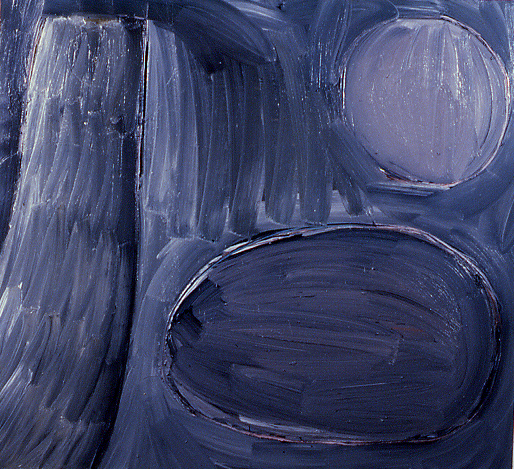
Steve Sas Schwartz "Objects in Space," 1983, oil on canvas
Although I had burned through money pretty quickly as a student, I decided that I had to buy something of Steve's. In early 1983 -- a few months after I graduated -- I paid $300 for "Insanity" and a bit more for a large grey canvas called "Objects in Space." Steve signed Insanity on the back with charcoal and added a ! after my name to add a bit more excitement. Naturally, his fingerprints are there too, another indication of the creative frenzy he had going in the studio. Steve recalls that in those days he was "pretty much coated in paint from hands to elbows."
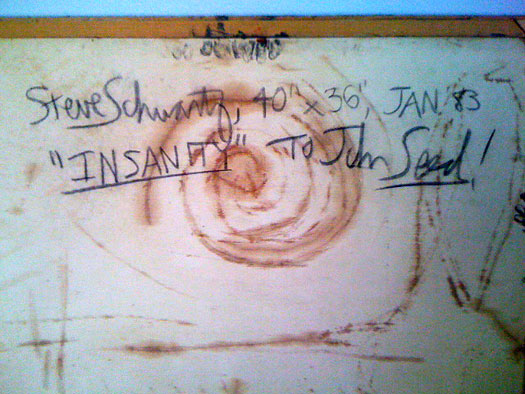
The back of "Insanity" with Steve's inscription
Life changed quickly after graduate school, and I went to work for the art dealer Larry Gagosian, who was an up and coming young dealer in Los Angeles. One day he asked me "Do you know any good young artists?" and I responded by bringing both of Steve's paintings to Larry's gallery on North Robertson the next day. He took them into his office and looked at them with a collector/client named Ira Young. When he left for the evening I asked him what he and Ira thought. "Tell your friend he needs to use better stretcher bars." was his comment. Sure enough, "Insanity" has always been a bit crooked on the stretchers. I was very disappointed that Larry hadn't seen the greatness I saw in Steve's work: it was a sobering "idealism meets art world reality" moment.
After that I took "Insanity" with me as I moved around, from Los Angeles to the Inland Empire. For about ten years it was in the storage racks where I teach at Mt. San Jacinto College until one afternoon I found that a few students had taken it out of the rack. A student asked me: "This is AMAZING Mr. Seed: did you do this?" I had to be honest, "I wish I had done it, but it was actually painted by a guy I used to know named Steve Sas Schwartz." My student tried to hide his reaction, but I could tell that he had just decided I was less cool than he had thought I was. That incident got me thinking: I had neglected a terrific painting.
After a quick cleaning I put some braces on the back corners -- it was still a bit tweaked -- and brought it home to my office. In a pleasant coincidence, I ran into Steve on Facebook just a few months later. He was pleased to know that "Insanity" was in my home office, and very understanding when I explained that I had sold my other Schwartz painting years before.
As I explained it to Steve a friend of a friend had given me $1,000 as the down payment on a commission. He wanted a painting of a waterfall to go over his fireplace in a very swank apartment. When he came to my studio to see the painting in progress he hated it: I wasn't the right person to paint waterfalls. In a panic, he looked around and saw Steve's big "Objects in Space" and told me "Hey, but I do like that painting: could I have that instead?" I shrugged, and gave it to him.
If you had asked me in 1983 "What painter friend of yours is going to be famous?" I would have answered without missing a beat: "Steve Schwartz." Of course, I have had the chance to know a few painters who became famous, including Jean Michel-Basquiat and his fame and early death were not pretty. Around the same time I met the artist Laddie John Dill and he had a few choice things say about the art world. "Look," I recall him saying about the art business, "it was crazy when I was a young artist and it is still crazy now." I know what he meant: the whole business of who gets famous, who gets shown, who gets sold... it's all nuts.
A few painters from our group at UCB have done very well, especially John Zurier and Eve Ascheim, both of whom are respected abstract painters. Interestingly, both of them make paintings that are much more austere and rigorous than Steve's. Could it be that what I liked in Steve's work -- the pure energy and drive -- wasn't in line with what the art world has wanted in the past few decades? Steve spent some time in New York after Berkeley, and he has had some good shows, sold a lot of work on his own, and gained the respect of a lot of artist friends. Still, he has never found a consistent niche or the right dealer.
In the end, who cares? I still like Steve's painting as a work of art, and I have a sentimental attachment to it as well. I have looked at it for years and had my own ideas about what the painting was about: that is if an abstract painting can be "about" something. Of course, with modern art we all get to have our own interpretations, so I get to say what "Insanity" means to me. I look at the painting and see youthful idealism and a romantic yearning to be connected with the spiritual powers of the world. Of course, the painting also reminds me of how "nuts" my time in graduate school was. When I recently asked Steve to tell me, in his own words, what "Insanity" means to him, he filled me in on his associations:
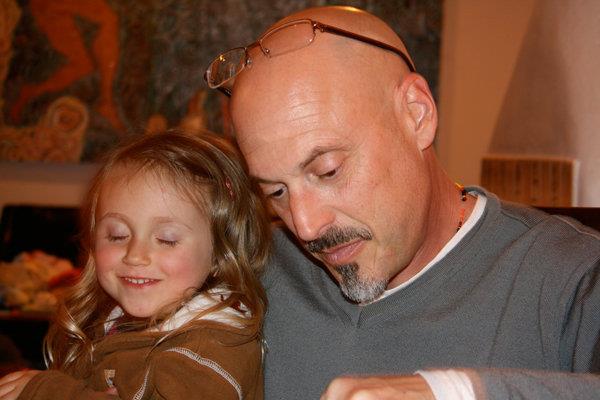
Steve Sas Schwartz
So there you have it. I have my own feelings about the painting, and Steve has his. Actually, our thoughts and feelings overlap in a few places, and I guess that is what you call "friendship" which is much more important to have in your life than fame. Of course, if Larry Gagosian should ever change his mind, "Insanity" has had its stretcher bars repaired, and I would be happy to loan it for a show.
Over time, I think the painting looks better and better. Steve, whose style has changed a lot over the years, still paints daily and tells me that "the mercurial nature of the so-called official art world has not daunted my output a bit."
My office at home started out sleek and minimal, but now that I have used it for a few years, it has become quite jammed with stuff. Every now and then I make a half-hearted attempt to clean it, but the clutter is winning. The shelves are stacked with art books and magazines, the in-box on my desk is bulging with unanswered mail, and the walls are plastered with old posters, framed drawings, and colorful sketches made by my daughters. Yes, it looks like the office of a busy middle-aged art writer/professor/dad, which I am.
Looming above the giant bean bag chair which my wife and three daughters lounge on when they come in to chat is a gnarly, riveting red, black and grey abstract oil painting. At one point or another each of my daughters has glanced up at it and asked me the same question: "Dad, what is that?"
"Well," I tell them, "that is 'Insanity' and it was painted by my friend Steve Sas Schwartz when he and I were grad students in painting at UC Berkeley in the early 1980s." At that point, the conversation generally shifts and we talk about other things, like when will their allowances be going up, or when can we get a new goldfish.

At the age of 24 I was a graduate student at UC Berkeley, a school where some noted veterans of the Bay Area art scene -- including Elmer Bischoff and Joan Brown -- were on the faculty. Before coming to Berkeley I had earned my BA in Art at Stanford University, a sprawling peaceful campus with broad green lawns where I felt sheltered from the world's gritty realities.
The first day I came to Berkeley to turn in some enrollment papers a man wearing a gas mask handed me a political pamphlet as I got out of my car. The spirit of 60s revolt was still alive at Berkeley, even during the Reagan presidency. Some of the good that had come out of the 60s -- the sense of idealism and the yearning for change -- was there, but so was a lingering sense of anger and disappointment. It was a stimulating and somewhat confusing place and time.
One of the first people I met at UCB was Steve Sas Schwartz, who was a few years younger than I was. He was a charismatic guy, a smooth talker, and an easy person to become acquainted with. Even before I got to know Steve well as a person I remember being interested in his paintings. He had a show in the Worth Ryder Gallery, downstairs in Kroeber Hall, that featured a group of small, dark geometric paintings along with some richly painted abstractions that featured lush, gestural applications of paint. Steve still has a photo of that show in his personal album.


For me, the atmosphere of the UC Berkeley Art Department was exhilarating: an arena you could paint your heart out in and then have intelligent discourse about what you created. I dug it and thrived in that environment. When painting in a large classroom of thirty or forty serious students I would routinely get into my zone and essentially barricade myself with humungous canvasses and a wall of gallon cans of Bay City oil paints, and I would basically dive in and lose myself.

I remember finding Steve's paintings very emotional, and their wacky and poetic titles added to the off-kilter, disconcerting energy. Steve says that "...many of my paintings at that time -- particularly the concentric circle galactic referential pieces -- had great titles such as "That totally blank feeling one gets from a completely meaningless experience in life," or "Two Suns Over Planet with Lake and Abstract Organisms Emerging Out of it at Dusk." Steve now calls the paintings he did between 1980 and 1984 his "Power Abstracts."
Steve's confidence and willingness to take chances with paint was very inspiring to me, but he got mixed reactions from others in the department. The instructors at Berkeley had some simmering differences with each other and we often got wildly contrasting feedback from them. Steve recalls that "one painting of mine literally received a standing ovation in one of Elmer Bischoff's crits: the very same painting was mocked so harshly by Joan (Brown) that the class sniggered. It took me ages to get my head around that."
It was very hard to know what was expected from those of us in the Master's program. One semester the department's small cash prize went to a student who placed metal plates on the floor Carl Andre style. I was underwhelmed. During one memorable exhibition another master's student showed small covered wagons with striped covers that let out a high pitched scream when they were plugged into the wall. Our instructors were all over the place artistically: I remember laughing out loud when one of them showed a large abstract painting titled "Whales Fucking" in the annual Faculty Exhibition.
One semester I took my graduate seminar at UC Davis to see if that department was a bit more coherent. My seminar leader was Jackie Winsor, a sculptor mainly known for dynamiting concrete cubes. One of the students I met was building small coffins which he filled with dioramas mainly constructed of melted jelly beans. Another student -- who I remember as deeply angry -- carved human figures from railroad ties with torches. I decided to return to Berkeley.


After that I took "Insanity" with me as I moved around, from Los Angeles to the Inland Empire. For about ten years it was in the storage racks where I teach at Mt. San Jacinto College until one afternoon I found that a few students had taken it out of the rack. A student asked me: "This is AMAZING Mr. Seed: did you do this?" I had to be honest, "I wish I had done it, but it was actually painted by a guy I used to know named Steve Sas Schwartz." My student tried to hide his reaction, but I could tell that he had just decided I was less cool than he had thought I was. That incident got me thinking: I had neglected a terrific painting.
After a quick cleaning I put some braces on the back corners -- it was still a bit tweaked -- and brought it home to my office. In a pleasant coincidence, I ran into Steve on Facebook just a few months later. He was pleased to know that "Insanity" was in my home office, and very understanding when I explained that I had sold my other Schwartz painting years before.
As I explained it to Steve a friend of a friend had given me $1,000 as the down payment on a commission. He wanted a painting of a waterfall to go over his fireplace in a very swank apartment. When he came to my studio to see the painting in progress he hated it: I wasn't the right person to paint waterfalls. In a panic, he looked around and saw Steve's big "Objects in Space" and told me "Hey, but I do like that painting: could I have that instead?" I shrugged, and gave it to him.
If you had asked me in 1983 "What painter friend of yours is going to be famous?" I would have answered without missing a beat: "Steve Schwartz." Of course, I have had the chance to know a few painters who became famous, including Jean Michel-Basquiat and his fame and early death were not pretty. Around the same time I met the artist Laddie John Dill and he had a few choice things say about the art world. "Look," I recall him saying about the art business, "it was crazy when I was a young artist and it is still crazy now." I know what he meant: the whole business of who gets famous, who gets shown, who gets sold... it's all nuts.
A few painters from our group at UCB have done very well, especially John Zurier and Eve Ascheim, both of whom are respected abstract painters. Interestingly, both of them make paintings that are much more austere and rigorous than Steve's. Could it be that what I liked in Steve's work -- the pure energy and drive -- wasn't in line with what the art world has wanted in the past few decades? Steve spent some time in New York after Berkeley, and he has had some good shows, sold a lot of work on his own, and gained the respect of a lot of artist friends. Still, he has never found a consistent niche or the right dealer.
In the end, who cares? I still like Steve's painting as a work of art, and I have a sentimental attachment to it as well. I have looked at it for years and had my own ideas about what the painting was about: that is if an abstract painting can be "about" something. Of course, with modern art we all get to have our own interpretations, so I get to say what "Insanity" means to me. I look at the painting and see youthful idealism and a romantic yearning to be connected with the spiritual powers of the world. Of course, the painting also reminds me of how "nuts" my time in graduate school was. When I recently asked Steve to tell me, in his own words, what "Insanity" means to him, he filled me in on his associations:
I believe 'Insanity' came from the energetic sense of whirling energy felt from the painting. This is a great piece, exemplifying all my concerns at the time: the enigmatic abstracted landscape with my trademark concentric circles now referencing other items. This piece really reads for me as galactic, yet earthbound, yet pure abstraction, yet surreal -- the erotic gestural symbols -- all at once. Hence: 'Insanity.'

Over time, I think the painting looks better and better. Steve, whose style has changed a lot over the years, still paints daily and tells me that "the mercurial nature of the so-called official art world has not daunted my output a bit."
